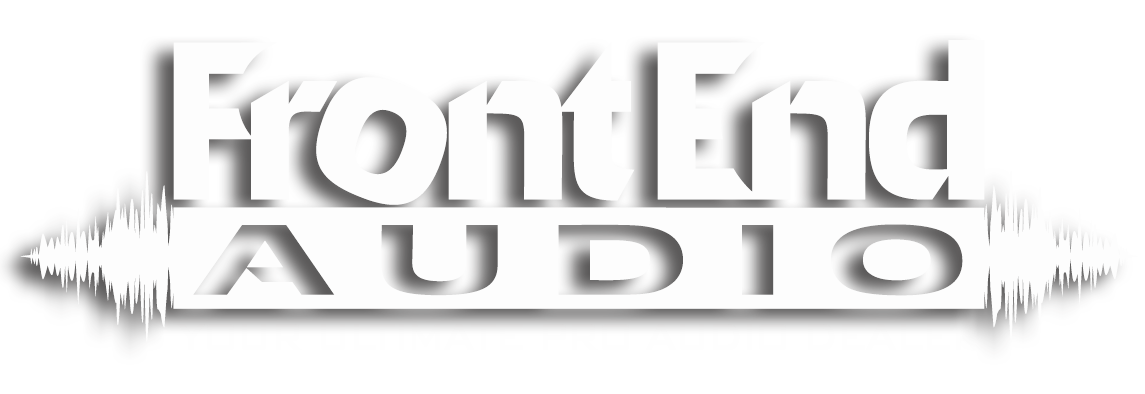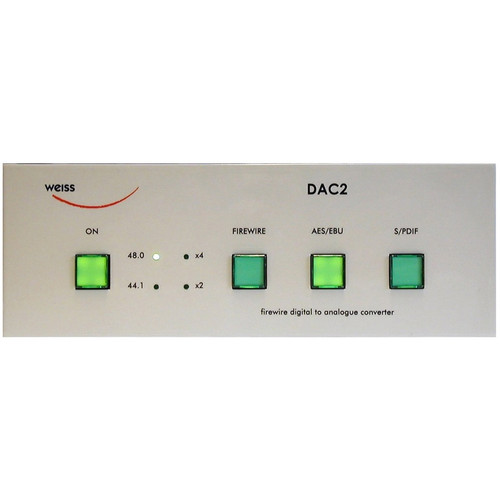The Weiss DAC2 DA Converter is a stereo 24 bit / 192khz D/A converter based on the renowned DICE Firewire chip of the TC Applied Technologies on the digital side and on the equally well received Burr Brown D/A converter chips on the analog side. This combination makes the DAC2 to be a flexible and very good sounding D/A Converter.
The Weiss DAC2 DA Converter functions as a high performance stereo, Firewire based, digital to analog and digital to digital converter and can be used either standalone or in conjunction with a PC or MAC computer. The Weiss DAC2 allows for various format conversions like Firewire to analog, AES/EBU to analog, Firewire to AES/EBU, AES/EBU to Firewire. In addition, the Weiss DAC2 offers a digital insert point between the Firewire input and the analog output. The analog output level can be controlled via the front panel keys.
Inputs
There are three digital inputs on XLR, RCA and TOSLINK (optical) connectors. In addition a computer can be connected via a Firewire interface. The accepted sampling frequencies are 44.1, 48, 88.2, 96, 176.4 and 192 kHz. AES/EBU signals in single wire or dual wire formats can be used. Digital outputs on XLR and RCA connectors are used to convert Firewire to AES/EBU and also for the insert point feature described below.
De-jittering
The DICE Firewire interface chip in the Weiss DAC2 uses a dual PLL scheme for clock (re-)generation. This yields a very high jitter suppression down to subsonic frequencies.
Output, Level Control
The Weiss DAC2 uses THAT line driver chips with low output impedance and excellent distortion figures. Separate driver chips are employed for the XLR and the RCA outputs. The output level can be set in the analog domain in four coarse steps to accommodate for the subsequent amplifier. Fine tuning of the level can be done via the digital level control which is operated via the front panel keys.
Front Panel Controls
The front panel shows a power key, three keys for the input selection and four LEDs for sampling frequency display. The front panel keys have several functions: The selecting of the input source, the enabling or disabling of the insert mode, which allows to insert a digital device in the signal chain between Firewire input and analog output and finally the setting of the output level in the digital domain with up/down controls.
Back Panel Elements
On the back panel there are three digital inputs (XLR, RCA, TOSLINK) and two Firewire sockets. Then there are two digital outputs (XLR, RCA) two pairs of analog outputs on XLR and RCA. The screwdriver operated rotary switch allows to set the analog output level in four coarse steps.
Internal Jumper Settings
Internal to the Weiss DAC2 there is a jumper to select the dual wire mode for 176.4 or 192 kHz signals.?
Bit Transparency Check
The Weiss DAC2 allows to check the player software running on the computer for Bit transparency. This is done by playing a test audio file on the computer. The Weiss DAC2 then checks whether it receives the special Bit pattern from the test file. This check is running in the background of the Weiss DAC2 software, i.e. as soon as the Weiss DAC2 detects such Bit patterns it flashes three of the LEDs on the front panel.
Optional Interfaces
Options for the Weiss DAC2 include an USB/DSD interface which allows to play back DSD files via the Weiss DAC2. A ST type glass fiber input is another option. For connecting the Weiss DAC2 to Thunderbolt there is a Thunderbolt to Firewire adapter available from Apple® at low cost.
Applications
The Weiss DAC2 can be used in many configurations: As a simple stand-alone AES/EBU input D/A converter, as a sound card for any Firewire or Thunderbolt equipped computer offering digital input/output and analog output facilities, as a monitoring DAC with multiple inputs including AES/EBU, S/PDIF, Firewire, Thunderbolt, USB. The Weiss DAC2 also is used in domestic setups for computer based music playback systems.
Weiss DAC2 DA Converter Features
- High performance stereo, Firewire based, digital to analog and digital to digital converter
- Stereo 24 bit / 192khz D/A converter
- TC Applied Technologies on the digital side
- Burr Brown D/A converter chips on the analog side
- Offers Firewire to analog, AES/EBU to analog, Firewire to AES/EBU, AES/EBU to Firewire Conversions
- Three digital inputs on XLR, RCA and TOSLINK (optical) connectors
- Computer can be connected via a Firewire interface
- Sampling frequencies are 44.1, 48, 88.2, 96, 176.4 and 192 kHz
- Uses a dual PLL scheme for very high jitter suppression down to subsonic frequencies
- THAT line driver chips with low output impedance and excellent distortion figures
- Separate driver chips are employed for the XLR and the RCA outputs
- Front panel has a power key, 3 keys for the input selection and 4 LEDs for sampling frequency display
- On the back panel there are three digital inputs (XLR, RCA, TOSLINK) and two Firewire sockets
- Internal jumper to select the dual wire mode for 176.4 or 192 kHz signals
- Allows checking the player software running on the computer for Bit transparency
- USB/DSD interface which allows to play back DSD files
- ST type glass fiber input and Thunderbolt to Firewire adapter for interfacing
Weiss DAC2 DA Converter Specifications
- AES/EBU Input:
- Sampling Frequencies: 44.1 kHz, 48 kHz, 88.2 kHz, 96 kHz, 176.4 kHz, 192 kHz
- Maximum Input Word-length: 24 Bits
- Channel Status Data: Input accepts professional or consumer format
- Connector: One XLR female (110 O), one RCA (75 O), one TOSLINK (optical)
- AES/EBU Output:
- One XLR male connector
- One RCA connector
- Firewire Input/Output: 2 x Firewire 400 sockets to allow for daisy-chaining of Firewire units
- Balanced Analog Output:
- Two XLR male connectors, pin 1 ground, pin 2 hot, pin 3 cold
- Symmetrical
- Servo circuit, i.e. pin 3 can be grounded for asymmetrical outputs
- Not earth free
- Short circuit proof
- DC coupled
- Output impedance 50 O
- Output Level Selectable via A Rotary Switch at the Back:
- +17 dBu (5.48 Vrms) with a 0 dBFS sine wave input
- +11 dBu (2.74 Vrms) with a 0 dBFS sine wave input
- +7.2 dBu (1.78 Vrms) with a 0 dBFS sine wave input
- +4.8 dBu (1.35 Vrms) with a 0 dBFS sine wave input
- Single Ended Analog Output:
- Two RCA connectors
- Asymmetrical
- Short circuit proof
- DC coupled
- Output impedance 50 O
- Output Level Selectable Via A Rotary Switch At The Back:
- +17 dBu (5.48 Vrms) with a 0 dBFS sine wave input
- +11 dBu (2.74 Vrms) with a 0 dBFS sine wave input
- +7.2 dBu (1.78 Vrms) with a 0 dBFS sine wave input
- +4.8 dBu (1.35 Vrms) with a 0 dBFS sine wave input
- Options:
- Thunderbolt interface via the Apple® Thunderbolt adapter
- USB interface with DSD to PCM conversion capability
- ST glass fiber input
- Software: Firewire drivers for Windows and OSX operating systems are supplied
- Measurements:
- Frequency Response: DC 20 kHz: ±0.3 dB
- THD+N at 1 kHz: At -3 dBFS input: -97 dB
- SNR at -20 dBFS Input: 107dB unweighted, relative to full scale output
- Linearity: From 0 dBFS to -120 dBFS input level: less than ±1 dB deviation from ideal
- Crosstalk: Less than -110 dB, DC 20 kHz
- Inter-Channel Phase Response: Less than ±0.5°, DC 20 kHz
- Power:
- Mains Voltage: 115 V or 230 V with voltage selector
- Fuse Rating: 250 mA at 115 V, 500 mA at 230 V, slow blow
- Power Consumption: 7 VA max.
- Power Consumption in Stand-by Mode: 3 VA max.
- Size:
- Depth: 30 cm
- Width: 18,8 cm
- Height: 6,6 cm (1.5HU)
Weiss DAC2 DA Converter Includes
- Weiss DAC2 DA Converter Unit
- Printed Operating Manual
















 Sign Up for exclusive sales and offers!
Sign Up for exclusive sales and offers!